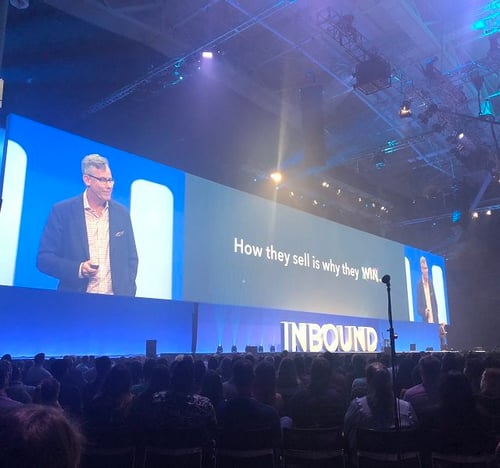5 things 256 discovered about search, chatbots and cyborgs at Learn Inbound

Posted by 256
November 2nd, 2017
Another year, another marketing conference. If you’re a marketer in Ireland, you’ll understand a common first-world problem: which marketing conference should you squeeze into your calendar this year? There’s the Web Summit, 3XE, DMX, Social Media Summit, and more to boot.
Learn Inbound has emerged as the standout. As MC Barry Adams concluded (with perhaps a twinge of bias), it’s the best marketing event in Ireland – and we’d have to agree.
Now in its fourth year, Learn Inbound has grown from the baby of the marketing scene into an insightful, mature event.
Moving from its home in The Academy to the swanky Round Room in the Mansion House, Learn Inbound welcomed 600 marketers to actionable talks from some of the biggest names in the biz.
If you weren’t fortunate enough to make it to the event on 1st November, we’ve rounded up some of our takeaways from the day that was. In a nutshell, the future is search – and as marketers, we stand to shape it.
So, onwards to what we learned!
1. Lexi Mills is the machine queen
What does the word ‘cyborg’ mean to you? The rise of the machines, Terminator or possibly the year 3017?
You couldn’t be blamed if any of those things spring to mind. At Learn Inbound, digital PR extraordinaire, Lexi Mills, used Google’s SERP to show us our collective (and potentially irrational) perception of futuristic technology. If you search for ‘cyborg’, this is what appears in Google’s sidebar:

Deceptive, if you dig into the etymology of the word – which, as Lexi pointed out, is a compound that is a mix of organic and mechanic. Your granddad could be a cyborg – presuming he has a hearing aid or a pacemaker.
This misconception around tech searches is common when it comes to search behaviour. Who hasn’t Googled their symptoms and prepared for impending death?
But SERP results should facilitate health. Google needs to be a realistic and unbiased source of information. According to Lexi, SEO specialists and content creators have a responsibility to normalise terms and technologies, and users have a responsibility to dive deeper and see search results in a wider context.
Google DeepMind is a tool that can compare personal data with global data records, and make recommendations grounded in fact.
The phrase ‘the future is now’ has never been more relevant. As Lexi pointed out, ‘the future is normal’; and we have nothing to be afraid of. Technologies such as AI, machine learning and IoT are the norm. It’s our jobs as marketers to understand the cogs and wheels beneath the trends.
2. Why we all need a chatbot in our lives
‘Are chatbots for all companies, or just for specific ones?’ – or so asked 256’s Paul McNulty in his follow-up interview with Microsoft’s Purna Virji after her chatbot presentation (it’s a good sign when you’re left with more questions than answers, we think).
The answer is yes – chatbots can be used to improve the customer journey and change the way users shop online, whether that’s a small pet shop or a big eCommerce store. It’s about moving from ‘buy now’ tactics to ‘how can I help you now?’, which will take personalised experiences to the next level.
But just how much can a bot help your business?
As Purna says, a study conducted in the financial sector showed that automatic responses to FAQs can save four minutes on average for every customer request. This doesn’t seem like much, but those four minutes can save a company eight billion dollars in five years.
Building a bot isn’t an expensive or inaccessible process. There are great third-party tools out there for marketers and non-devs: Microsoft Bot Framework will give you the code you need to build a bot. It’ll also connect the bot to your platform, but you will need to provide the AI and creative content – which is the heart and brains of your bot.
The first step is to build conversational skills for your bot, by highlighting the pain-points of the customer journey (as if you were drafting a content strategy). A tip from Purna is to ask the most non-tech savvy person you can find to go through the purchase journey from start to finish, and to highlight any areas of confusion.
You can then use these insights and FAQs to build your bot’s answers. A great free tool is qnamaker.ai, which can be populated with natural language questioning to teach your bot conversational skills. No coding required!
But for your bot to work, it must be in the right place at the right time – so it’s important to optimise your content for query-based searches, and appeal to the conversational nature of search terms.

3. The ranking game: local SEO and quick-win tactics
Michael King, founder of iPullRank and technical SEO strategist, touched on the importance of traditional methods with an audience-focused approach.
An important factor for Mike is ‘whole number’ keyword volume (not a range). Tools which still provide whole number volume are KeywordTool.io, GrepWords, and Ahrefs. Three more tactics he recommends for quick SEO wins are:
- Topic-modelling (optimising your content for TF*IDF)
This is one of the biggest ranking factors for content. The algorithm identifies the key topic on a page, and then assigns a weight to that topic (your TF*IDF score).The score is determined by how ‘unique’ that topic is. Mike says he has seen brands improve rankings by optimising for this algorithm alone. You can get started with free tools like OnPage.org to check your TF*IDF score. If it needs some improvement, make sure to include keywords with higher search volumes and lower competition. - Social shares are more important than link building
A hugely underestimated factor for ranking is the number of social shares on your content. Mike and his team found a higher correlation with crawling and social shares than with crawling and links – which means link building now takes a back seat to social engagement metrics. This echoes a trend shared by ‘Wizard of Moz’, Rand Fishkin, at the last Learn Inbound event, but it’s good to hear an affirmation. - Don’t get caught out by non-indexed JavaScript
An interesting point Michael made was that, ‘Nothing that requires a user action to be displayed will ever be indexed.’ A workaround? Use Screaming Frog to crawl in txt mode, and in JavaScript mode, then compare the hash columns. Then make sure there are no disparities.
4. Self-managed teams and predictive behaviour
Genuinely’s Mackenzie Fogelson’s was the anomaly, as her focus forwent technology for organisational structure and business purpose. A theme she shared with other speakers was one of ‘transformation.’
In place of the rise of machines, she spoke of the rise of teams via team transformation and an established practice of self-awareness. It’s all well and good to future-proof systems and software, she claims, but first, we must start with the humans behind the technology.
However, it loops back to machines: this human transformation can be achieved through a predictive analysis model of sorts. Certain behavioural triggers can be predicted and managed, and there are quick-fix tools out there to help managers achieve this.
Two tools she favours are from the Conscious Leadership Group (which shows how to break free from the leadership drama triangle), and a traffic light system from Reboot. This can be managed with weekly check-ins and team chartering using a Trello board. It seems fluffy, Mackenzie admits, but it is the glue that holds the team together.
5. Asking the right questions: Featured Snippets and Google Trends
Featured Snippets featured heavily across the day. According to both Wil Reynolds and Michael King, it takes six to seven months to begin ranking for a keyword. By optimising your content for Snippets instead, you can potentially rank on position 0 for a target keyword or phrase in a matter of hours.
Nice – but how do you go about doing this? It comes back to the theme of conversational search and optimising content for query-based search terms. In a nutshell, the steps are to:
- Research the Query Space.
- Put the Query in a Header Tag.
- Place the right structured text in close proximity.
- Watch the magic happen.
Interestingly, Lexi Mills’ talk on PR SEO also highlighted the importance of discovering all current questions people are asking. She uses Google Trends as a key tool for discovering these queries. But that’s just the first step – she then takes these niche, trending topics, and turns them mainstream.
For example, the Internet of Things is quite a heavy, techy topic. To bring it into the mainstream, Lexi and her team made a robotic bag.
Suddenly, the Internet of Things was blown wide open as a theme, as it had been married with fashion – accessible to anyone who owns a handbag. This strategy doesn’t just pin-point audiences; it curates trends, and in doing so, creates new audiences by showing them things they never thought they needed.
Which is, by all accounts, marketing in a nutshell.
Want a future-proofed content strategy for your brand?
We specialise in data-driven marketing strategies, from research to content optimisation for Google SERP. Why not get in touch for a chat?

Previous Post
Global content governance – making sense of the chaos
Next Post

3 essentials of a LinkedIn marketing strategy every B2B marketer needs to know
Subscribe Here
You may also like...
Bryan Arnott | Sep 9, 2019
Bryan Arnott | Nov 29, 2018





